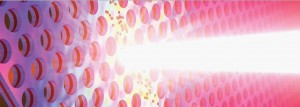Jan 29 2016
Researchers at the University of Valencia are working on a new semiconductor laser that is up to 1000 times more energy-efficient than laser devices currently in use, earning them a spot in Optica journal’s top 30 breakthroughs in 2015.
 Thresholdless laser at room temperatures
Thresholdless laser at room temperatures
Researchers at the Universitat de València (University of Valencia, UV) are working alongside experts from Madrid and Zurich to develop and test an ultra-low-threshold laser device that operates at room temperatures. Such a device would have the potential to increase computing speeds by several orders of magnitude.
The lasing threshold is the minimum amount of energy required in order for a laser device to begin emitting light. A full explanation of this concept and the pumping action behind it can be found in the links provided, and in the feature published in the Optical Society of America’s Optica. For now it is enough to know that the lower this threshold, the more efficient the laser device, and that “thresholdless lasers have been a holy grail since the laser’s invention” (Optica).
The device tested at the UV’s Optoelectronic Devices and Materials Unit (UMDO) is based on the optical emission of semiconductor nanostructures embedded in a photonic crystal microcavity, emitting in the 1286 nanometre wavelength, the second spectral window in optical fibre telecommunications where inefficient temporal dispersion is low. Its lasing threshold is very low, near-thresholdless. But more than that it operates at room temperature or above, rather than the -296ºC needed by existing near-thresholdless laser devices. This fact alone significantly reduces running costs and makes its incorporation into production lines a practical reality.
Taking all three factors into account —wavelength, threshold and operation temperature— it tests at between 100 and 1000 times more energy-efficient than standard laser devices.
A laser device of this kind has many applications. Easily integrated into fibre optic circuitry, it will enable the development of massively faster computers, advanced data storage technologies and ultra-sensitive biosensors.
This research is the joint effort of experts at the UV’s Optoelectronic Devices and Materials Unit (UMDO), the Institute of Microelectronics of Madrid (IMM, part of the Spanish National Research Council (CSIC)) and the Laboratory for Solid State Physics at the Swiss Federal Institute of Technology (ETA Zurich).